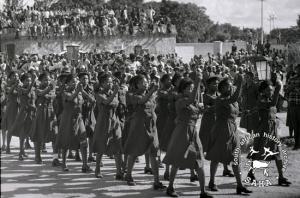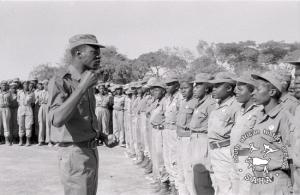 The decision to form a separate unit for women soldiers was evidently motivated by Joshua Nkomo. From evidence in the interviews he was uncomfortable having the men and women together and was also uncomfortable with the women becoming a fighting force. Sibongile Khumalo elaborates:
The decision to form a separate unit for women soldiers was evidently motivated by Joshua Nkomo. From evidence in the interviews he was uncomfortable having the men and women together and was also uncomfortable with the women becoming a fighting force. Sibongile Khumalo elaborates:
You know he had a good policy. His thinking was that "Why waste a seed? These women are the ones who will replace those soldiers who would have died in the front, so why waste a seed. All we have to do is to prepare these girls for administrative work, yes".
Nkomo preferred to deploy them after basic training for training in such roles as police, nurses, secretarial etc. However, it is not clear from the interviews exactly how the decision was taken to form a separate brigade.
 The brigade was first formed in 1977. At that time Victory Camp was being designated as a holding camp for women and girls, and selections were made for those who wanted to be trained as soldiers, those who would continue with education and those who might be teachers or sent for other non-military training. There appeared to be a policy that everyone not going for primary or secondary education should have military training first before going for other training, but evidently this was not strictly adhered to, as many went straight for other courses.
The brigade was first formed in 1977. At that time Victory Camp was being designated as a holding camp for women and girls, and selections were made for those who wanted to be trained as soldiers, those who would continue with education and those who might be teachers or sent for other non-military training. There appeared to be a policy that everyone not going for primary or secondary education should have military training first before going for other training, but evidently this was not strictly adhered to, as many went straight for other courses.
The brigade was formed at Victory Camp, and the first group remained there while the training camp at Mkushi was being prepared. It seems that almost all of the photographs of the brigade were taken at Victory Camp, perhaps even mostly on the same day when there was a parade. The chief of personnel, Ambrose Mutinhiri, is seen addressing them in this photograph. Grace Noko explains how the brigade was formed and what role they initially played:
…when the brigade was now being formed, we had about 200 ladies who were now at the Victory Camp … So since we now had the trained personnel among women … it was also now on the security side, helping men and the Zambians to … teach our people, the ladies, … how they should behave in that camp, and also teaching those who were supposed to go for the training the slight or light training like how to handle guns, stripping the guns and also some … doing some exercises in the morning.


